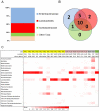Bacterial communities of diverse Drosophila species: ecological context of a host-microbe model system
- PMID: 21966276
- PMCID: PMC3178584
- DOI: 10.1371/journal.pgen.1002272
Bacterial communities of diverse Drosophila species: ecological context of a host-microbe model system
Abstract
Drosophila melanogaster is emerging as an important model of non-pathogenic host-microbe interactions. The genetic and experimental tractability of Drosophila has led to significant gains in our understanding of animal-microbial symbiosis. However, the full implications of these results cannot be appreciated without the knowledge of the microbial communities associated with natural Drosophila populations. In particular, it is not clear whether laboratory cultures can serve as an accurate model of host-microbe interactions that occur in the wild, or those that have occurred over evolutionary time. To fill this gap, we characterized natural bacterial communities associated with 14 species of Drosophila and related genera collected from distant geographic locations. To represent the ecological diversity of Drosophilids, examined species included fruit-, flower-, mushroom-, and cactus-feeders. In parallel, wild host populations were compared to laboratory strains, and controlled experiments were performed to assess the importance of host species and diet in shaping bacterial microbiome composition. We find that Drosophilid flies have taxonomically restricted bacterial communities, with 85% of the natural bacterial microbiome composed of only four bacterial families. The dominant bacterial taxa are widespread and found in many different host species despite the taxonomic, ecological, and geographic diversity of their hosts. Both natural surveys and laboratory experiments indicate that host diet plays a major role in shaping the Drosophila bacterial microbiome. Despite this, the internal bacterial microbiome represents only a highly reduced subset of the external bacterial communities, suggesting that the host exercises some level of control over the bacteria that inhabit its digestive tract. Finally, we show that laboratory strains provide only a limited model of natural host-microbe interactions. Bacterial taxa used in experimental studies are rare or absent in wild Drosophila populations, while the most abundant associates of natural Drosophila populations are rare in the lab.
Conflict of interest statement
The authors have declared that no competing interests exist.
Figures




References
-
- Markow TA, O'Grady P. Oxford, UK: Elsevier; 2006. Drosophila: A guide to species identification and use.
-
- Jones CD. The genetics of adaptation in Drosophila sechellia. Genetica. 2005;123:137–145. - PubMed
-
- Markow TA, O'Grady P. Reproductive ecology of Drosophila. Functional Ecology. 2008;22:747–759.
-
- Markow TA, O'Grady PM. Evolutionary genetics of reproductive behavior in Drosophila: Connecting the dots. Annual Review of Genetics. 2005;39:263–291. - PubMed
-
- Jaenike J. Parasite Pressure and the Evolution of Amanitin Tolerance in Drosophila. Evolution. 1985;39:1295–1301. - PubMed
Publication types
MeSH terms
Substances
LinkOut - more resources
Full Text Sources
Other Literature Sources
Molecular Biology Databases
Miscellaneous

